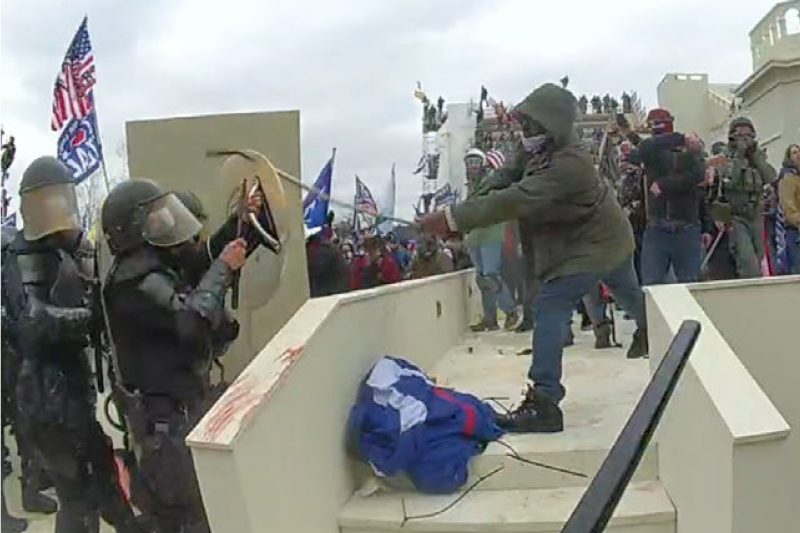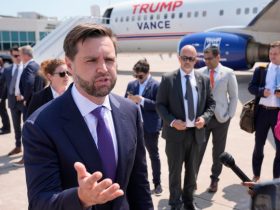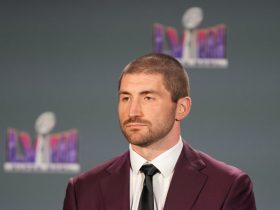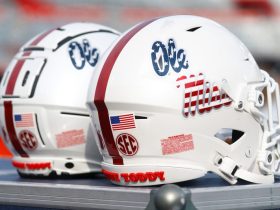The riot at the U.S. Capitol on Jan. 6, 2021, would not have happened had it not been for President Donald Trump’s response to his election loss the previous November. Trump’s months of dishonest and baseless claims about the election being stolen — claims that remain baseless to this day — provided the central motive for the mob’s anger. It was also Trump’s encouragement that brought the members of the mob to D.C., beginning with a tweet on Dec. 19, 2020, in which he called people to the city on Jan. 6. The enticement to his followers? The day “will be wild.”
It was wilder than most people expected. The mob surrounded and then stormed into the Capitol, forcing its way past police officers, 140 of whom were assaulted. If only for a few hours, the process of formalizing Trump’s loss was derailed, just as Trump hoped.
Since the events of that day, though, there’s been another question that’s lingered around the day: How much direct responsibility does Trump bear for the violence that unfolded? Some, pointing to Trump’s having put in place the necessary components for the mob, might simply declare that the question has been settled. Others, insisting on distinguishing between Trump’s incitement and the reaction of those outside the Capitol, have argued that the riot was an unfortunate progression of what he advocated.
With the release of a summary report from the House select committee investigating the riot — a document released two years to the day after the “will be wild” tweet — there are enough pieces in place to largely resolve the circumstantial nature of Trump’s culpability for the day’s violence. One can now make a case that Trump knew specifically that there was a risk of violence, that he pushed people to the Capitol despite that risk and that he stood aside once the violence began.
Based on the committee’s report, this is that case.
We will start in the middle.
Shortly before the mob started pushing into the Capitol, Trump was speaking just outside of the White House. Long concerned about the size of crowds at his events, he reportedly expressed frustration that a secure area just in front of the stage was only partially filled.
Cassidy Hutchinson, a senior aide to White House Chief of Staff Mark Meadows, was with Trump at the time. She recalled Trump asking that the magnetometers (“mags,” as she put it) be turned off and the space filled.
“He was angry that we weren’t letting people through the mags with weapons — what the Secret Service deemed as weapons,” she explained. “I overheard the President say something to the effect of, ‘I don’t F’ing care that they have weapons. They’re not here to hurt me. Take the F’ing mags away. Let my people in. They can march to the Capitol from here. Let the people in. Take the F’ing mags away.’”
That is enormously revelatory. Trump knew that people in the audience were armed and that he was not at risk from their weapons. And if he knew he wasn’t at risk, it suggests he knew who might be: members of Congress or other political opponents.
The committee report details the weapons seized from those who entered the secure area: “242 cannisters [sic] of pepper spray, 269 knives or blades, 18 brass knuckles, 18 tasers, 6 pieces of body armor, 3 gas masks, 30 batons or blunt instruments, and 17 miscellaneous items like scissors, needles, or screwdrivers.” Some of these probably weren’t intended to be used offensively; lots of people carry pepper spray for self-defense. It’s harder to explain away brass knuckles.
Others entered the secure area but left bags potentially containing weapons outside. Some, the report suggests, simply watched the speech from outside the secure area. As the Secret Service’s Tony Ornato texted Hutchinson, “people on the monument side don’t want to come in. They can see from there and don’t want to come in. They can see from there and don’t have to go through mags.”
Among those who didn’t pass through the metal detectors were several individuals carrying firearms.
“Three men in fatigues from Broward County, Florida brandished AR-15s in front of Metropolitan police officers on 14th Street and Independence Avenue on the morning of January 6th. [Metropolitan police] advised over the radio that one individual was possibly armed with a ‘Glock’ at 14th and Constitution Avenue,” the report states, “and another was possibly armed with a ‘rifle’ at 15th and Constitution Avenue around 11:23 a.m. The National Park Service detained an individual with a rifle between 12 and 1 p.m.” This was a manifestation of numerous warnings law enforcement and the Secret Service had received about the threat of violence on the day.
None of this would have mattered had the attendees of Trump’s speech simply stayed near the White House. But during his speech, Trump called for his audience to march to the Capitol — the audience, remember, that he knew was carrying weapons.
Such a march had long been the plan. The day’s events ended up being a blend of several different rallies and protests organized by different groups. Those were eventually unified, with a website promoting the Jan. 6 events at one point encouraging a march from Trump’s speech to the Capitol. But White House lawyers recognized the danger, telling Trump’s speechwriters not to call for a march, “for legal concerns and also for the optics of what it could portray the president wanting to do that day,” Hutchinson told the committee.
So, the march idea became a planned surprise.
“On January 2, 2021, [Trump adviser] Katrina Pierson wrote in an email to fellow rally organizers, ‘POTUS expectations are to have something intimate at the [E]llipse, and call on everyone to march to the Capitol,’” the report reads. “And, on January 4, 2021, another rally organizer texted Mike Lindell, the MyPillow CEO, that President Trump would ‘unexpectedly’ call on his supporters to march to the Capitol.” There was even a draft tweet calling for a march, a tweet never sent.
Trump, of course, wanted to go further, suggesting to the crowd at his rally that he’d go to the Capitol with them, something that Hutchinson said his attorney, Rudy Giuliani, had been excited about.
“The President’s going to be there,” she said he told her. “He’s going to look powerful. He’s — he’s going to be with the members. He’s going to be with the Senators.” This, too, had been a subject of concern among Trump’s lawyers.
Instead, Trump went back to the White House, apparently not entirely of his own volition. There, he was very quickly informed that violence had broken out on Capitol Hill. He had asked a staffer if they had watched his speech, the report states, but the staffer noted that the speech had been cut off to cover the riot.
“The President asked what they meant by that,” the report reads. “‘They’re rioting down there at the Capitol,’ the employee repeated. ‘Oh really?’ the President asked. ‘All right, let’s go see.’”
This appears to be much of what Trump did for the next several hours: see the riot unfold. There’s no indication he did anything to try to stamp out the violence as it was underway. One campaign staffer texted Trump’s longtime aide Hope Hicks cajoling her to get Trump to “tweet something about Being NON-violent.”
“I suggested it several times Monday and Tuesday,” Hicks replied, “and he refused.” Not terribly surprising given that Trump’s original pitch for the day was a “wild” protest, an idea that inspired many of those later charged with entering the Capitol.
The report, mirroring past hearings held by the committee, found no evidence that Trump spoke out against the violence or took action — before or during the riot — to stamp out any violence.
Considered in its totality, the picture presented is clear. Trump enticed people to come to Washington with his “wild” tweet. He and his allies proposed a march but, with attorneys recommending against the idea, downplayed the idea until it “suddenly” appeared in Trump’s speech.
At which point, Trump knew people in the audience were armed and law enforcement knew that there were numerous existent threats. Yet Trump called for people to march to the Capitol anyway, even enticing them further by promising that he’d join them there. At least one ally had pushed for him to insist the day’s events be peaceful; beyond one mention of being peaceful in his speech — that came as he called for the march — he declined to do so.
He soon learned the mob wasn’t being peaceful. He took no apparent action to call for them to curtail any violence for several hours.
One could argue that the riot blindsided Trump, that his entreaties to come to Washington and that his dishonesty about the election were unfortunate but well-meaning triggers for the day’s events. But the evidence compiled by the committee tarnishes that generous idea severely.
Trump knew violence was a risk and had been warned about it. He knew the crowd was capable of violence and who might be the target of that violence. He knew there was a danger in pointing people at the Capitol. He knew violence was underway soon after it began. He took no tangible steps before or at the outset of the riot to stem the violence.
Nothing he did suggests he had any problem with the way in which all of those things came together on the steps of the Capitol.








